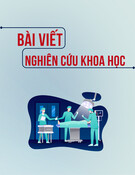
Journal of Science and Technology in Medicine and Pharmacy | Vol 2, No 5 - 2023 |
111
Editor-in-Chief:
Dr. Nguyen Phuong Sinh
Received:
10/8/2023
Accepted:
10/11/2023
Published:
31/12/2023
Copyright: @ 2023
Belongs to the Journal of
Science and Technology in
Medicine and Pharmacy
Competing interests: The
authors have no competing
interests to declare.
Contact address: No. 284,
Luong Ngoc Quyen str., Thai
Nguyen city, Thai Nguyen
Province
Email:
tapchi@tnmc.edu.vn
UTILITIES OF DIABETES PATIENTS WITH
COMPLICATIONS IN A MEDICAL CENTER,
THAI NGUYEN, VIETNAM
Huong Thi Thu Hoang2, Khuong Ba Cao1, Nam Minh
Hoang1, Lan Thi Phuong Nguyen1*
1 Thai Nguyen University of Medicine and Pharmacy
2 Department of Disease Control HIV/AIDS, Medical Center of
Thai Nguyen City.
*Author contact: nguyenthiphuonglan@tnmc.edu.vn
ABSTRACT
Background: Complications are considered the critical
contributors to lower health-related quality of life among diabetes
patients. Objectives: This study aimed to estimate utility of
diabetes patients and identify potential predictors of health-state
utilities among these populations. Methods: A cross-sectional
study was implemented to assess the health state utilities and
potential predictors among diabetes patients who suffered from
diabetes complications. The SF-36v2TM was utilized to collect
data regarding health-state utilities. Possible predictors of the
utilities were assessed using a linear regression model. Results:
Mean ±Standard deviation of the utility was 0.62±0.05. The
predictors of health-state utilities were found including age (Coef.
= -0.001, 95%CI -0.002; 0.000), blood glucose (Coef. = -0.008,
95%CI -0.013; -0.003), and insulin therapy (Coef. = -0.504,
95%CI -0.064; -0.045). Conclusion: The health-state utilities
found among diabetes patients with complications in this study
were comparable to recent investigations. Age, blood glucose
levels, and insulin therapy were predictors of the health-state
utility.
Keywords: Diabetes; Complication; Health-state utilities; Utility;
Predictors.
INTRODUCTION
The prevalence of diabetes among adults aged 20 to 79
worldwide was 1.5% in the year 2021, and it is predicted to be
12.2% (78.3 million) in 20451. Diabetes can lead to many
complications such as diabetic retinopathy, kidney complications,

112
| Journal of Science and Technology in Medicine and Pharmacy | Vol 2, No 5 - 2023
neurological complications, and infectious complications2. The
quality of life of the diabetic patient is significantly impacted by
the complications. Studies have revealed that diabetic patients
with complications had lower quality of life than healthy
individuals, even with the mildest complication3. Diabetes-
mellitus related complications could be the key contributors to
lower health-related quality of life of the patients4,5.
To assess the outcomes of diagnosis and therapy, many outcome
measures can be used as critical elements for disease management
cost-effectiveness analysis. Health related Quality of Life
(HRQoL) is one of the measures. Notably, precise assessments of
diabetes patients' utilities can help health economists evaluate
proposed diabetes care programs. Currently, relatively limited
information about diabetes patients' health-state utilities is
accessible in Vietnam.
Researchers have used the Quality Metrics’ Short-form 36 version
2TM (SF-36v2TM) to gather HRQoL data6. This tool has also been
used in diabetic patients’ management in several countries7-10.
This instrument has previously been validated in several Asian
countries11-14, particularly in Vietnam15.
In this study, the SF-36v2TM questionnaire was used to collect
data from diabetes patients with at least one complication who
were being under the management of the Medical Center of Thai
Nguyen City to measure their HRQoL expressed in utilities.
Besides, this study aimed to identify potential predictors of health-
state utilities among the study population.
METHODS
Subjects: All confirmed diabetic patients with at least one
diabetes complication and being managed by the Medical Center
of Thai Nguyen City were invited to enroll in the study. Inclusion
criteria were (1) diabetes patients being managed by the
department and, (2) being diagnosed as having at least one of the
diabetes complications by a doctor at the department and (3) able
to respond to the questionnaire and (4) agree to enroll in the study.
Location: Diabetes patients who are managed at the Medical
Center of Thai Nguyen City.

Journal of Science and Technology in Medicine and Pharmacy | Vol 2, No 5 - 2023 |
113
Timeline: Data was collected from 1 September to 30 November
2021.
Methods
Study design: A cross-sectional study was applied in this study.
Sample size: There was a total of 307 diabetes patients who
satisfied the inclusion criteria among 1224 patients being
managed by the medical center at the time of this study.
Variables
The following independent variables were collected: (1)
demographic information including urban or rural residence, age,
sex, occupation, education, marital status, perceived economic
status, and marital status; (2) diabetes management-related
variables such as duration from diabetes diagnosis time point,
duration of receiving treatment, complications of diabetes, blood
glucose and HbA1c concentration; insulin therapy (Yes/No). The
dependent variables to assess health-state utilities was collected
using the SF-36v2TM.
Instruments and measurements: Some instruments can be used
to measure utility scores among diabetes patients such as EQ-5D,
SF-6D (SF-36v2), SD-6Dv216,17. Particularly, original valuation of
SF-36v2TM data was utilized by Brazier et al. to produce an
algorithm with no potential mapping errors6. This algorithm has
been recently reported to explain about 60% of the reasonable
share of variances and as a reliable measurement of health
impacts, particularly when only minor differences in health are
expected18, as in diabetes management. Therefore, the estimation
of health utilities in this study was performed using Brazier et al.’s
algorithm based on SF-36v2TM data and the Vietnamese version of
SF-36v2TM was used to gather data on health status.
For the application of the algorithm, there were eleven specific
questions in six domains of SF-36 were chosen to estimate health-
state utilities: questions 3, 4 and 12 in the physical domain;
questions 15 and 18 in the role domain; question 32 in the social
domain; question number 21 and 22 in the pain domain; questions
24 and 28 in the mental domain; and question 27 in the vitality
domain. Utilities were subsequently estimated based on responses

114
| Journal of Science and Technology in Medicine and Pharmacy | Vol 2, No 5 - 2023
elicited by standard gambling techniques18. Procedures to acquire
health utility scores using the algorithm were described in a recent
study15.
To mitigate information bias, investigators from Thai Nguyen
University of Medicine and Pharmacy were trained to perform
face-to-face interviews in both fundamental interview skills and
interview structure based on the questionnaire. A practical
component was also included to ensure that all the investigators
had a comparable understanding and used the questionnaire
consistently.
Data on patients’ demographic characteristics were collected
during interviews and diabetes management-related variables
were gathered from participants’ medical records.
Statistical analysis
Descriptive statistics included frequency, percentage, mean, and
standard deviation. Since the utility score was normally
distributed, independent T-test, and ANOVA were utilized to
determine associations between the outcome and independent
variables. The independent variables were gender, age group,
education level, occupation, marital status, perceived economic
status, time of diabetes diagnosis, duration of treatment, blood
glucose level, HbA1c, BMI, and insulin therapy. A multivariate
linear regression model with all the independent variables
included for predictors determination. Normality of data,
linearity assumption, autocorrelation, and multicollinearity
were checked for the linear regression model. In case of
multicollinearity occurred, the related variables were removed
from the model. Data was analyzed by using SPSS Statistic for
Windows, Version 23.0.
Ethical consideration
Those invited to complete the questionnaire were provided with a
brief description of the study and its objectives. The participants
were enrolled after they consented to participate and for the data
provided to be used. No identifying information was collected.
The study was approved by the Ethics Committee of Thai Nguyen
University of Medicine and Pharmacy (No 1156/ĐHYD-HĐĐĐ).
RESULTS

Journal of Science and Technology in Medicine and Pharmacy | Vol 2, No 5 - 2023 |
115
Table 1. General characteristics of the participants (n=307)
Variables
n
%
Gender
Male
152
49.5
Female
155
50.5
Age groups (years)
Under 50
25
8.1
From 50 to 59
74
24.1
Above 59
208
67.8
Occupation
Farmer
135
44.0
Retired
72
23.5
Freelancer
71
23.1
Worker
15
4.9
Officer
14
4.6
Education level
Primary school/None
12
3.9
Secondary school
42
13.7
High school
161
52.4
College and above
92
30.0
Perceived self-economic
status
Independence
163
53.1
Partially independence
101
32.9
Dependence
43
14.0
Marital status
Married
278
90.6
Divorced/widow
23
7.5
Single
6
1.9
Total
307
100
The baseline characteristics of 307 participants are shown in
Table 1. Half of the participants were female (50.5%). Most of the
patients were over 60 years old (67.8%). The education levels of



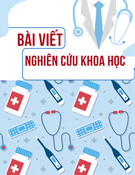
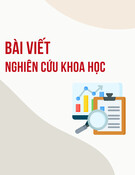
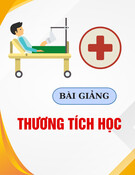





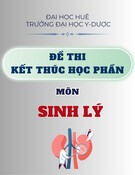
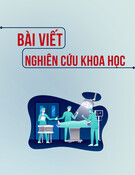
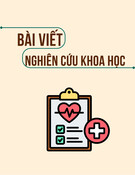
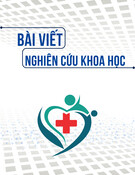

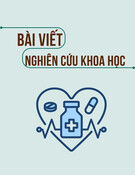

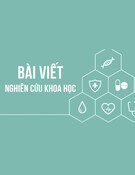
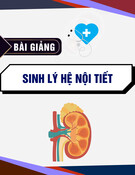


![Bài giảng Cập nhật vấn đề hồi sức bệnh tay chân miệng nặng [mới nhất]](https://cdn.tailieu.vn/images/document/thumbnail/2025/20250920/hmn03091998@gmail.com/135x160/23301758514697.jpg)


